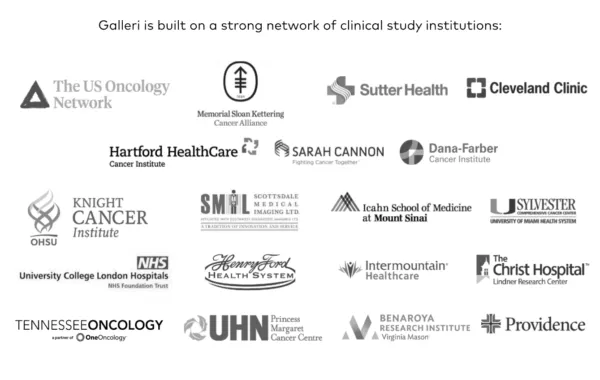Breakthrough test performance
Galleri® is a clinically validated cancer screening test designed to allow you to see the previously undetectable
The Galleri test does not detect a signal for all cancers and not all cancers can be detected in the blood. False positive and false negative results do occur.

The Galleri test does not detect a signal for all cancers and not all cancers can be detected in the blood. False positive and false negative results do occur.
More cancers are detected early by adding the Galleri® test1
The Galleri test screens for more than 50 cancer types2, most of which lack recommended screening tests. The more aggressive the cancer, the more likely the Galleri test is to detect a cancer signal.2
*Compared to USPSTF A & B screening alone. USPSTF A or B rating includes breast, cervical, colorectal, and lung screenings. Based on the first ~25,000 participants with 1 year of follow-up. 3 times as many cancers were detected when the Galleri test was added to USPSTF screenings A,B & C.

Galleri sets a high standard for multi-cancer early detection
Published in top-tier peer-reviewed journals such as the Lancet and Annals of Oncology, the Galleri test has been rigorously studied with demonstrated performance in case-controlled and interventional studies.1,2,3
Lowest False Positive Rate of Any MCED1,4
0.4%
The Galleri test’s low false positive rate, reflective of its high specificity of 99.6%, helps minimize unnecessary diagnostic procedures, exposure to radiation, and patient anxiety.1,5 In patients without cancer, the Galleri test will give a false positive result approximately 1 in 250 individuals.1
Specificity = proportion of people without cancer who received No Cancer Signal results
Test performance metrics do not represent results of a head-to-head comparative study. Separate studies have different designs, objectives, and participant populations, which limits the ability to draw conclusions about comparative performance.
High Positive Predictive Value1
61.6%
The Galleri test's strong PPV gives clinical confidence in a Cancer Signal Detected result. For the Galleri test, 6 out of 10 patients with a positive test result will be diagnosed with cancer.1
What is PPV? The proportion of people diagnosed with cancer after a Cancer Signal Detected result.
High Cancer Signal Origin Accuracy
93.4%
The Cancer Signal Origin (CSO) indicates the tissue or organ most likely associated with the cancer signal.3 The ability to predict the CSO with high accuracy is an essential function of an MCED test to help guide a targeted, efficient diagnostic workup.6 In patients with a cancer diagnosis after a Cancer Signal Detected test result, the Galleri test’s Cancer Signal Origin accurately predicted the cancer location in 93.4% of cases.7‡
‡In clinical study participants with a cancer diagnosis after Cancer Signal Detected test result.
What is the Galleri test's sensitivity?
Galleri has high sensitivity, 76.3% across all stages, for 12 deadly cancers responsible for two-thirds of cancer deaths in the US.2,8*†
Sensitivity varies by cancer type and stage. More aggressive cancers tend to shed more DNA into the blood at earlier stages2 and are more likely to be detected by the Galleri test.3
The overall sensitivity for cancer detection is 51.5% for all cancer types and across all stages.2 This provides the opportunity to detect many additional cancers when added to recommended single-cancer screening tests.
*Anus, bladder, colon/rectum, esophagus, head and neck, liver/ bile duct, lung, lymphoma, ovary, pancreas, plasma cell neoplasm, and stomach
†In case-controlled clinical study of participants with cancer. In PATHFINDER 2, an interventional study of patients without suspicion of cancer, a 12 month episode sensitivity was calculated to be 73.7% for 12 cancers responsible for two-thirds of cancer deaths and 40.4% for all cancer types.
| Cancer Classes | Sensitivity, proportion of true positives |
|---|---|
| Liver/Bile-duct |
|
| Head and Neck |
|
| Esophagus |
|
| Pancreas |
|
| Ovary |
|
| Colon/Rectum |
|
| Anus |
|
| Cervix |
|
| Urothelial Tract |
|
| Lung |
|
| Plasma Cell Neoplasm |
|
| Gallbladder |
|
| Stomach |
|
| Sarcoma |
|
| Lymphoma |
|
| Other |
|
| Melanoma |
|
| Lymphoid Leukemia |
|
| Bladder |
|
| Breast |
|
| Uterus |
|
| Myeloid Neoplasm |
|
| Kidney |
|
| Prostate |
|
| Thyroid |
|
See publications supporting Galleri test performance
Ongoing clinical evidence program backed by 380,000+ participants
The GRAIL clinical evidence program includes more than 380,000 participants in completed or ongoing studies. To support and validate our technology, studies are being performed at leading health systems and community and academic medical centers in the US and United Kingdom.

The Galleri test is recommended for use in adults with an elevated risk for cancer, such as those age 50 or older. The test does not detect all cancers and should be used in addition to routine cancer screening tests recommended by a healthcare provider. The Galleri test is intended to detect cancer signals and predict where in the body the cancer signal is located. Use of the test is not recommended in individuals who are pregnant, 21 years old or younger, or undergoing active cancer treatment.
Results should be interpreted by a healthcare provider in the context of medical history, clinical signs, and symptoms. A test result of No Cancer Signal Detected does not rule out cancer. A test result of Cancer Signal Detected requires confirmatory diagnostic evaluation by medically established procedures (e.g., imaging) to confirm cancer.
If cancer is not confirmed with further testing, it could mean that cancer is not present or testing was insufficient to detect cancer, including due to the cancer being located in a different part of the body. False positive (a cancer signal detected when cancer is not present) and false negative (a cancer signal not detected when cancer is present) test results do occur. Rx only.
The GRAIL clinical laboratory is certified under the Clinical Laboratory Improvement Amendments of 1988 (CLIA) and accredited by the College of American Pathologists. The Galleri test was developed — and its performance characteristics were determined — by GRAIL. The Galleri test has not been cleared or approved by the Food and Drug Administration. The GRAIL clinical laboratory is regulated under CLIA to perform high-complexity testing. The Galleri test is intended for clinical purposes
- Nabavizadeh N, et al. Safety and performance of MCED test in an intended-use population: initial results from the registrational PATHFINDER 2 study [proffered presentation]. ESMO Congress; 2025 Oct 17-21; Berlin.
- Klein EA, Richards D, Cohn A, et al. Clinical validation of a targeted methylation-based multi-cancer early detection test using an independent validation set. Ann Oncol. 2021;32(9):1167-77. DOI: https://doi.org/10.1016/j.annonc.2021.05.806.
- Schrag D, Beer TM, McDonnell CH, et al. Blood-based tests for multi-cancer early detection (PATHFINDER): a prospective cohort study. Lancet. 2023;402:1251-1260. doi: 10.1016/S0140-6736(23)01700-2
- GRAIL, Inc. False positive rate. [Data on file: GR-2025-0256]
- Bolejko A, et al. Cancer Epidemiol Biomarkers Prev. 2015 Sep;24(9):1388-97.
- Hackshaw A, Clarke CA, Hartman AR. New genomic technologies for multi-cancer early detection: Rethinking the scope of cancer screening. Cancer Cell. 2022;40(2):109-113. DOI: https://doi.org/10.1016/j.ccell.2022.01.012.
- GRAIL, Inc. Enhanced Cancer Signal Origin prediction.[Data on file: VV-TMF-59592]
- American Cancer Society. Cancer Facts & Figures 2022. Atlanta: American Cancer Society; 2022 https://www.cancer.org/research/cancer-facts-statistics/all-cancer-facts-figures/cancer-facts-figures-2022.html.
- GRAIL, Inc. Demonstrated performance in individuals screened for cancer. [Data on file: GA-2025-0257]